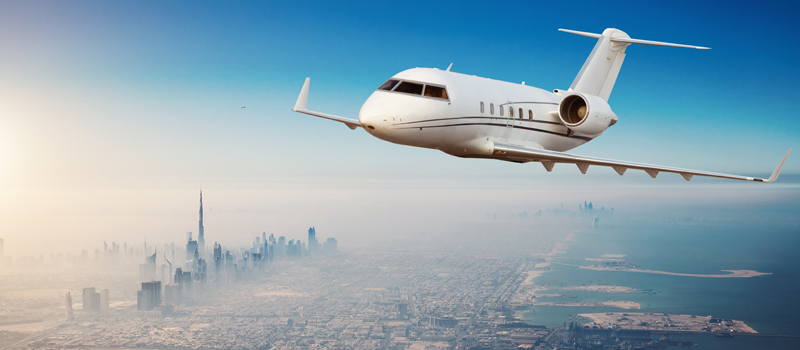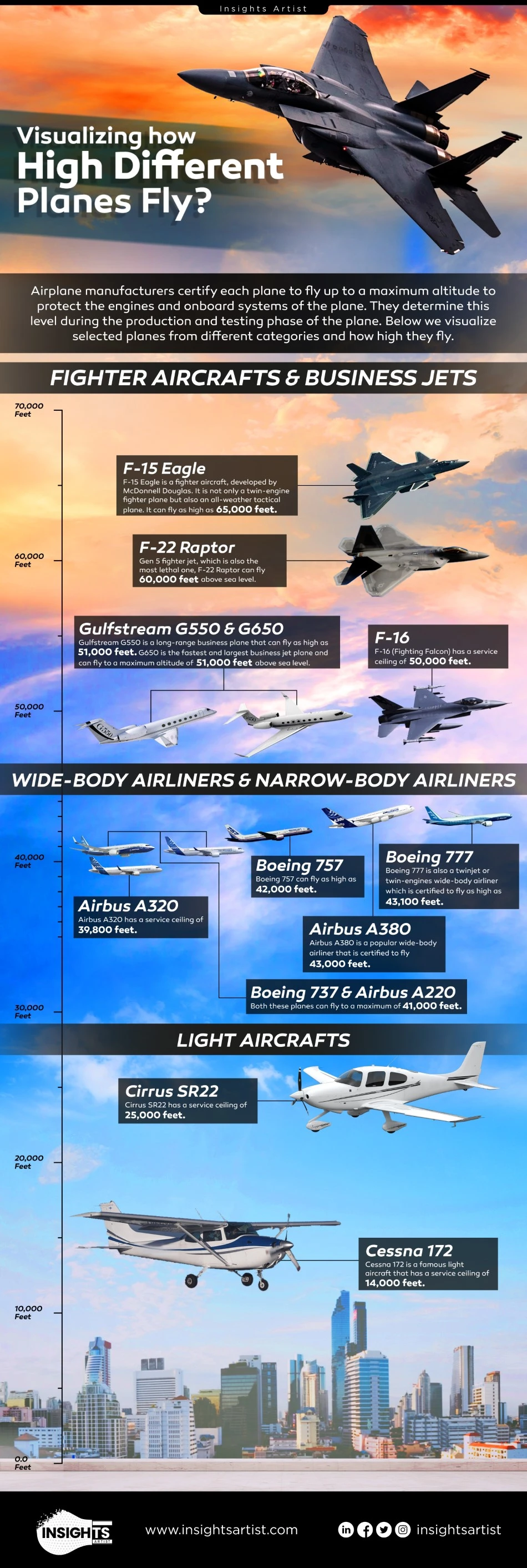How High Do Planes Fly? Unveiling Aviation Secrets

Planes typically fly at altitudes ranging from 31,000 to 38,000 feet. These high altitudes ensure efficiency and safety during flights.
Flying at high altitudes allows planes to travel more efficiently and safely. Altitudes for planes generally range from 31,000 to 38,000 feet. This altitude provides a balance between fuel efficiency and passenger comfort. The air at higher altitudes is thinner, reducing drag on the aircraft and enabling it to fly faster and more economically.
Additionally, flying at higher altitudes keeps planes above most turbulent weather conditions, ensuring a smoother journey for passengers. Pilots carefully monitor and adjust the altitude during the flight to optimize performance and passenger experience.

Credit: pilotinstitute.com
The Flight Envelope: Altitudes Explored
When it comes to flying, altitudes play a crucial role in ensuring safe and efficient travel. Aircraft are designed to operate within specific altitude ranges, known as the flight envelope. Understanding these altitudes is essential not only for pilots and aviation professionals but also for curious passengers who wonder just how high planes can fly.
Typical Cruising Altitudes For Commercial Jets
Commercial jets, such as those used for passenger travel, typically cruise at altitudes ranging from 30,000 to 40,000 feet. These altitudes provide several advantages, including smoother airflow, reduced fuel consumption, and increased speed. The specific cruising altitude for a given flight depends on various factors, such as aircraft type, weather conditions, and air traffic control directives.
At higher altitudes, commercial jets can take advantage of thinner air, resulting in decreased air resistance. This allows them to achieve higher speeds while consuming less fuel. Additionally, cruising at higher altitudes helps to avoid adverse weather conditions, such as turbulence, which are more common at lower altitudes.
Altitude Variations Across Aircraft Types
Altitude capabilities can vary across different types of aircraft. While commercial jets typically cruise at the altitudes mentioned earlier, smaller propeller-driven aircraft may operate at lower altitudes. These aircraft are often used for regional flights and may fly at altitudes ranging from 10,000 to 20,000 feet.
On the other hand, military aircraft and specialized jets, such as business jets and supersonic aircraft, can reach much higher altitudes. Military jets, like fighter jets, can fly at altitudes exceeding 50,000 feet, enabling them to perform various tactical maneuvers and maintain a higher level of safety.
Business jets, designed for corporate and private use, can also reach impressive altitudes. Some business jets can fly as high as 51,000 feet, allowing for smoother flights and shorter travel times. Lastly, supersonic aircraft, like the Concorde, were capable of flying at altitudes above 60,000 feet, enabling them to achieve supersonic speeds.
In conclusion, altitudes play a crucial role in aviation, with different aircraft types operating within specific altitude ranges. From commercial jets cruising at 30,000 to 40,000 feet to military and supersonic aircraft reaching altitudes exceeding 50,000 feet, the flight envelope encompasses a wide range of altitudes to ensure safe and efficient travel.
Physical And Technical Limits In Aviation
Planes reach cruising altitudes between 30,000 and 40,000 feet, where the air is thinner, allowing for smoother travel and less fuel consumption. Commercial aircraft typically fly around 35,000 feet, maximizing efficiency and safety while avoiding most weather disturbances.
The Role Of Air Pressure And Temperature
Air pressure and temperature are two of the most significant factors that affect how high planes can fly. As altitude increases, air pressure decreases, making it harder for planes to maintain lift. Additionally, temperature drops as altitude increases, affecting the density of the air that the plane needs for lift. A plane must be designed to withstand these changes in order to fly at high altitudes.
Aircraft Design And Engine Performance Factors
Aside from air pressure and temperature, aircraft design and engine performance are also critical factors in determining a plane’s maximum altitude. The design of the wings, the size and shape of the fuselage, and the weight of the plane all play a role in determining how high a plane can fly. Additionally, the engine’s power and efficiency affect how much thrust it can generate, which is required to propel the plane to higher altitudes. In conclusion, understanding the physical and technical limits of aviation is crucial to designing and operating planes that can fly at high altitudes. By considering factors such as air pressure, temperature, aircraft design, and engine performance, engineers can create planes that can reach greater heights and travel farther distances than ever before.
Airspace Classes And Flight Levels
In aviation, understanding the different airspace classes and flight levels is crucial for pilots and air traffic controllers alike. These concepts help regulate and organize air traffic to ensure safe and efficient operations. Let’s explore the differences between controlled and uncontrolled airspace, as well as how flight levels are assigned.
Controlled Vs. Uncontrolled Airspace
Controlled airspace refers to areas where air traffic control services are provided. In these regions, pilots must obtain clearance from air traffic control before entering. This ensures that all aircraft within the controlled airspace are aware of each other’s presence and follow specific regulations. Controlled airspace is divided into different classes, each with its own set of rules and requirements.
On the other hand, uncontrolled airspace lacks air traffic control services. Pilots have more freedom and responsibility to navigate within these areas. However, they must still adhere to general aviation rules and remain vigilant to avoid potential conflicts with other aircraft.
How Flight Levels Are Assigned
Flight levels are altitude references used primarily in cruise flight. They are typically based on standard atmospheric pressure and are measured in hundreds of feet. Flight levels start at 100 and increase incrementally, with each flight level representing a specific altitude.
The assignment of flight levels depends on the region and the air traffic control system in place. In most cases, flight levels are assigned based on the altimeter setting, which adjusts the altimeter reading to reflect the current atmospheric pressure. This ensures that all aircraft within the same flight level are flying at a consistent altitude relative to the standard pressure level.
In certain areas, flight levels may be subject to restrictions or specific requirements, such as minimum or maximum altitudes for certain routes or airspace classes. These restrictions help maintain separation between aircraft and enhance safety.
Understanding airspace classes and flight levels is crucial for both pilots and air traffic controllers to ensure the smooth and safe flow of air traffic. By following the rules and regulations associated with each airspace class and accurately assigning flight levels, aviation professionals can effectively manage the skies.
Jet Streams And Their Influence On Altitude
Jet streams significantly impact the altitude at which planes fly, with commercial aircraft typically cruising between 30,000 to 40,000 feet above sea level. These high-altitude bands of strong wind play a crucial role in shaping flight routes and travel times across the globe.
Navigating The High-altitude Winds
When it comes to flying at high altitudes, jet streams play a significant role in influencing the flight path of an aircraft. These narrow bands of strong winds, typically found at altitudes above 30,000 feet, can have a profound impact on the speed, direction, and fuel efficiency of planes.
Fuel Efficiency And Jet Streams
Jet streams are like fast-moving rivers of air in the Earth’s atmosphere. They can flow at speeds exceeding 100 miles per hour and are created by the differences in temperature between the Earth’s equator and the poles. While jet streams can flow in various directions, the most common ones are the polar jet stream and the subtropical jet stream.
The polar jet stream, located at higher latitudes, usually between 30,000 and 50,000 feet, blows from west to east. On the other hand, the subtropical jet stream, found closer to the equator, operates at altitudes ranging from 25,000 to 35,000 feet, also moving from west to east. These high-altitude winds can extend for thousands of miles and can greatly affect the flight paths of aircraft.
When aircraft fly with the jet stream, they benefit from its strong tailwind, which can significantly increase their ground speed. This boost in speed allows planes to reach their destinations more quickly, saving both time and fuel. On the contrary, flying against the jet stream can increase flight times and fuel consumption, as the headwind slows down the aircraft’s progress.
Flight planners and pilots carefully analyze the position and strength of jet streams to optimize flight paths and enhance fuel efficiency. By taking advantage of favorable tailwinds, airlines can reduce the duration of flights and minimize fuel consumption, resulting in cost savings and reduced carbon emissions.
Moreover, jet streams can also impact the cruising altitude of planes. Pilots often choose altitudes where the jet stream’s speed and direction align with their desired flight path. By riding the jet stream, aircraft can maintain higher ground speeds and maximize fuel efficiency, as the tailwind compensates for the increased air resistance at higher altitudes.
However, it’s important to note that flying at extremely high altitudes is not always ideal. While the jet stream can provide benefits, there are also factors to consider, such as increased turbulence and the potential for stronger crosswinds. Pilots must strike a balance between the advantages of the jet stream and the safety and comfort of passengers.
In conclusion, jet streams have a significant influence on the altitude at which planes fly. By understanding the behavior of these high-altitude winds, pilots can navigate more efficiently, improve fuel efficiency, and enhance the overall flight experience for passengers.
Safety Considerations At High Altitudes
When considering the safety of high-altitude flying, several critical factors come into play. Understanding the necessary precautions and safety measures at high altitudes is essential for a smooth and secure flight experience.
Oxygen Supply And Cabin Pressurization
At high altitudes, the air becomes thin, necessitating the use of supplemental oxygen to ensure the well-being of passengers and crew. Aircraft are equipped with systems that regulate cabin pressure, maintaining a safe and comfortable environment for everyone on board.
Emergency Procedures For Rapid Decompression
In the event of rapid decompression, where there is a sudden loss of cabin pressure, the aircraft is designed to deploy oxygen masks automatically. Passengers are instructed to secure their own masks before assisting others, ensuring their safety in the event of an emergency.
Credit: www.quora.com
The Experience Of Flying High: Passenger Perspective
Effects Of High Altitude On Human Body
At high altitudes, the human body may experience effects such as decreased oxygen levels and lower humidity, leading to dryness and discomfort.
Comfort And In-flight Entertainment
Passengers can enjoy enhanced comfort with features like spacious seating, adjustable headrests, and personalized in-flight entertainment options.
Environmental Impact Of High-altitude Flights
High-altitude flights have a significant environmental impact that extends beyond just fuel consumption.
Emissions And The Ozone Layer
Airplanes emit pollutants that can harm the ozone layer, leading to increased UV radiation.
The Future Of Eco-friendly Flying
Innovations like electric planes and sustainable fuels aim to reduce the carbon footprint of air travel.
Advancements In High-altitude Flight Technology
Advancements in High-Altitude Flight Technology have revolutionized the way we approach air travel.
Innovations In Aircraft Design
Modern aircraft feature sleek designs and lightweight materials to achieve higher altitudes.
The Future Of Aviation And Space Travel
Cutting-edge technologies promise exciting possibilities for space exploration and long-distance travel.

Credit: insightsartist.com
Frequently Asked Questions
How High Do Commercial Airplanes Fly?
Commercial airplanes typically fly at cruising altitudes ranging from 30,000 to 40,000 feet. This high altitude allows for smoother air, reduced fuel consumption, and greater safety from weather and other air traffic.
What Is The Highest Altitude A Plane Can Reach?
The highest altitude reached by commercial airplanes is around 45,000 feet. This altitude is limited by factors such as air density, engine performance, and the aircraft’s design and capabilities.
Why Do Planes Fly At High Altitudes?
Planes fly at high altitudes to benefit from thinner air, which reduces drag and allows for more fuel-efficient travel. Additionally, higher altitudes provide better routing options and help avoid weather and other air traffic.
Do Planes Fly Higher At Night?
Planes may fly slightly higher at night due to cooler air temperatures, which can improve engine performance and fuel efficiency. However, the difference in altitude is generally minimal and primarily based on individual flight conditions.
Conclusion
Understanding how high planes fly can be fascinating for many people. The altitude at which planes fly is dependent on various factors such as the type of aircraft, weather conditions, and air traffic control restrictions. However, regardless of the altitude, planes have revolutionized the way we travel and transport goods across the world.
As technology advances, we can expect to see even higher altitudes achieved by planes in the future.



